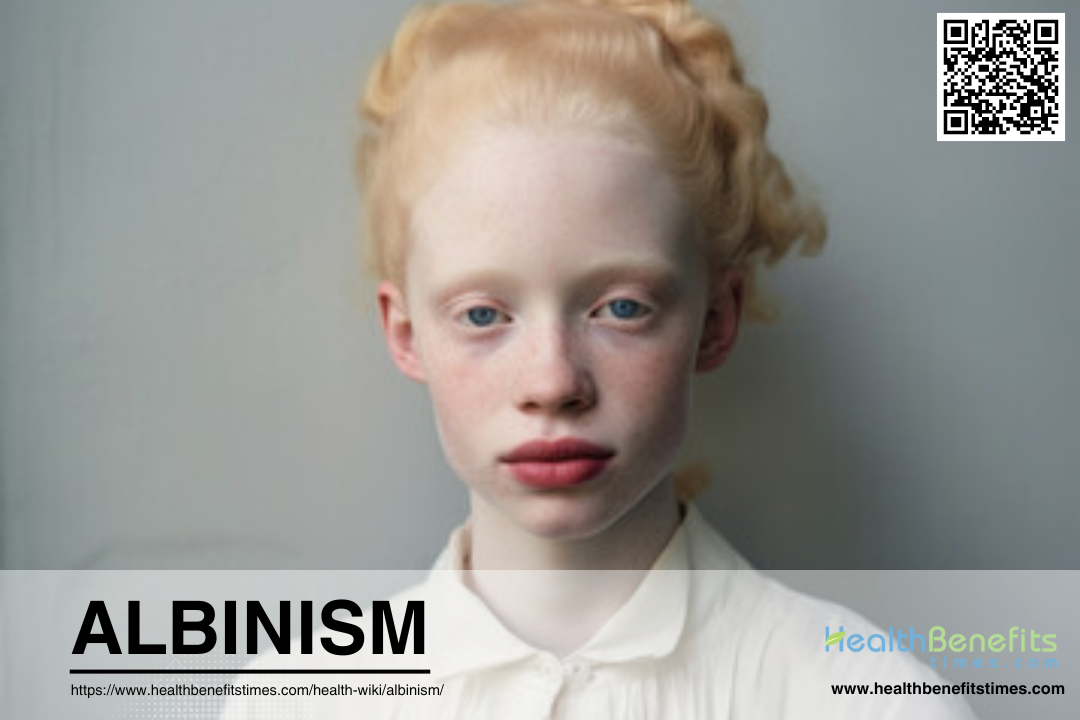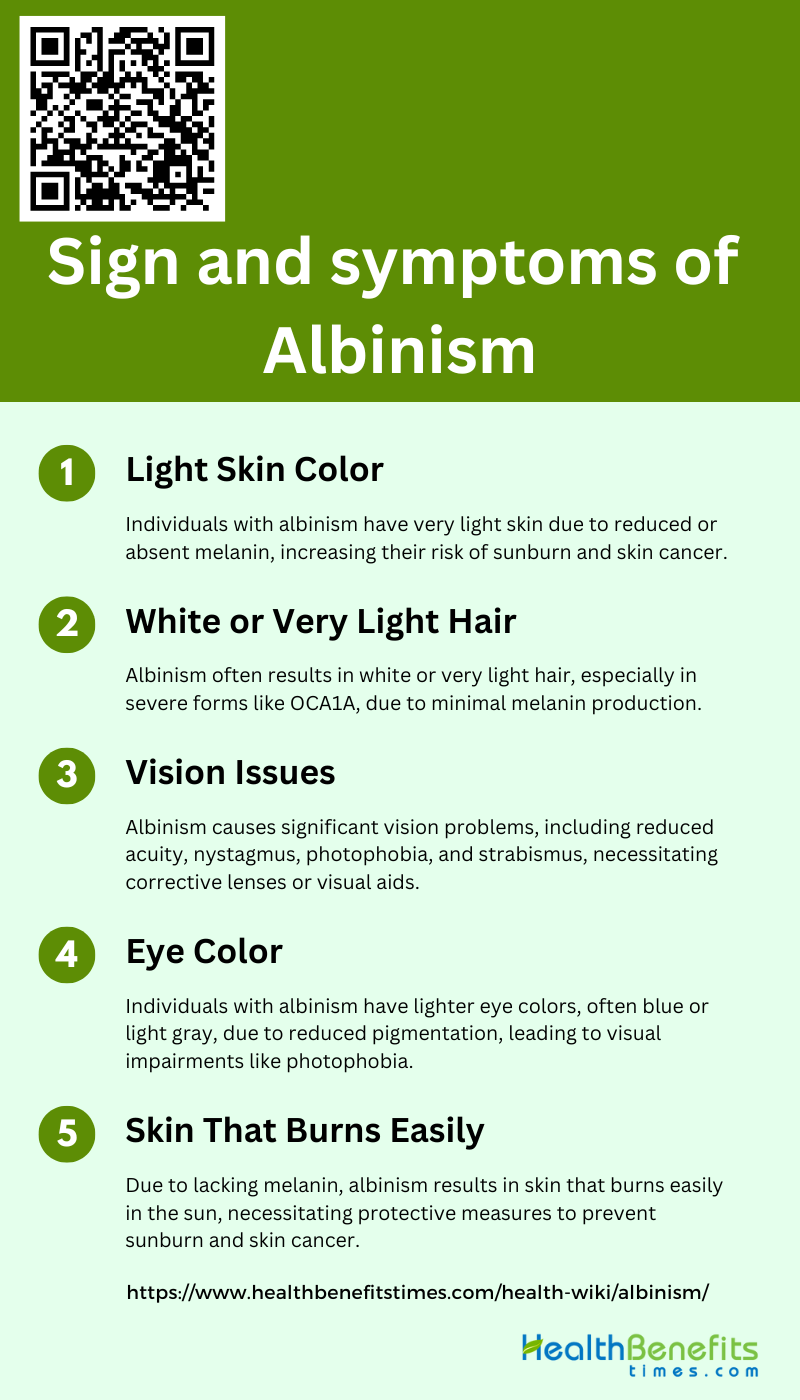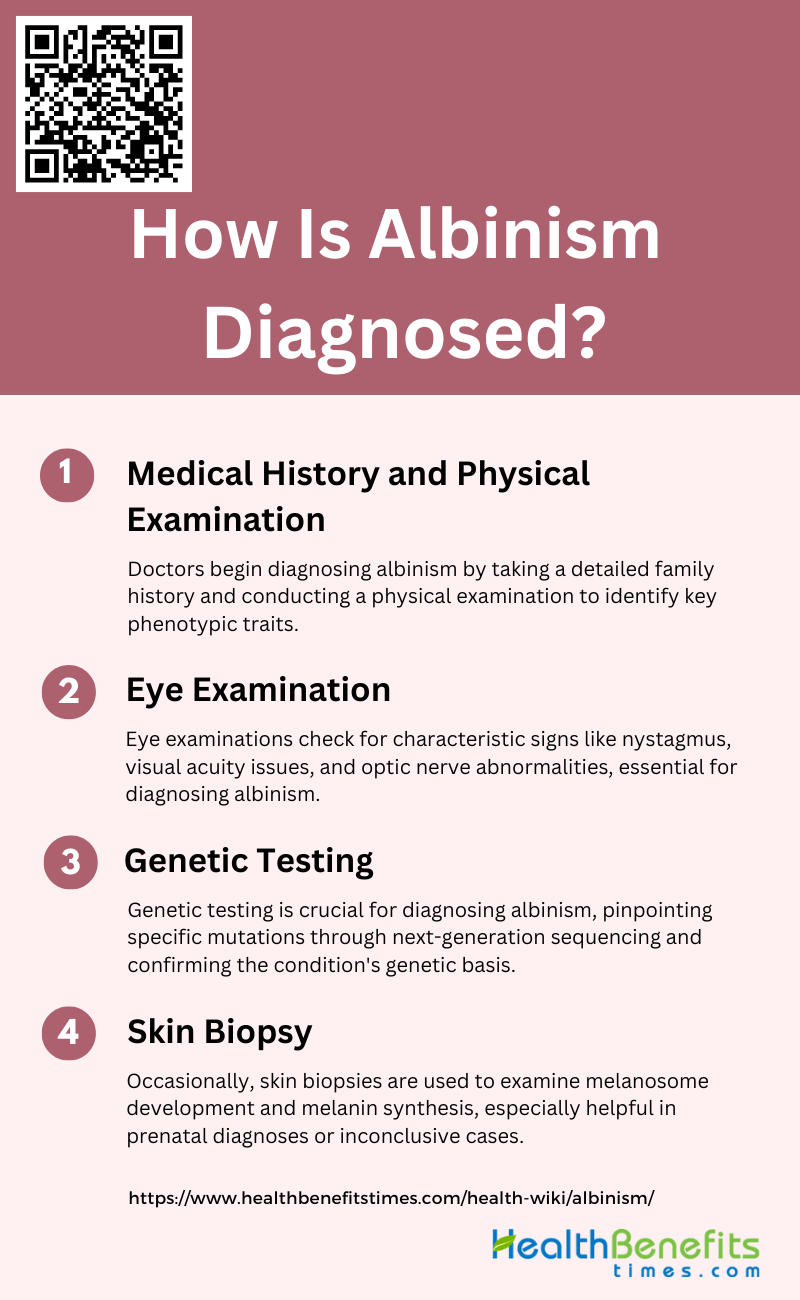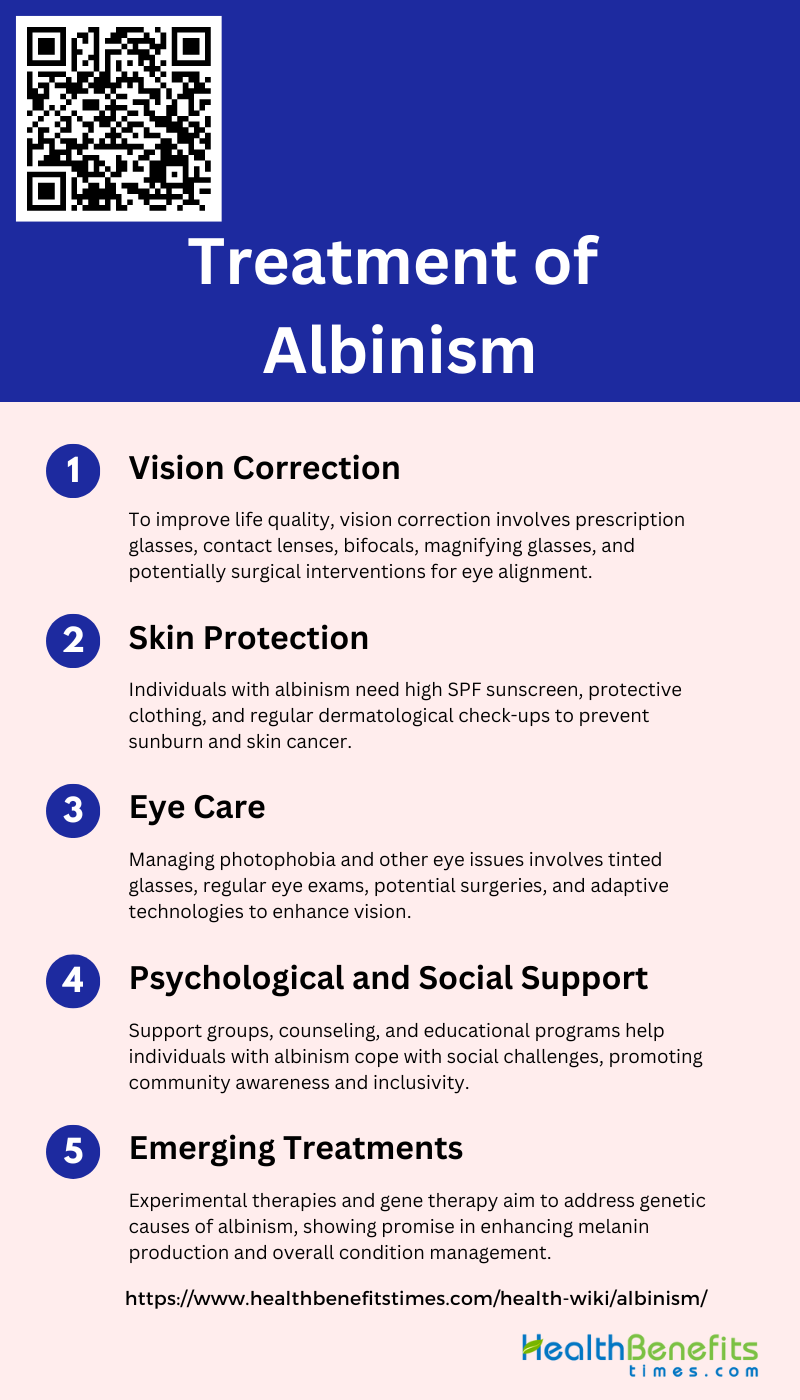 Albinism is a genetic condition characterized by a significant reduction or complete absence of melanin, the pigment responsible for coloring the skin, hair, and eyes. This condition results from mutations in specific genes that affect melanin production, leading to very light skin, hair, and eyes, and often causing vision problems due to the lack of pigment in the eyes. Albinism can be classified into two main types: oculocutaneous albinism (OCA), which affects the skin, hair, and eyes, and ocular albinism (OA), which primarily affects the eyes. People with albinism are more susceptible to sunburn and skin cancer due to their lack of melanin, which normally provides some protection against ultraviolet (UV) radiation. While there is no cure for albinism, symptoms can be managed with protective measures and supportive treatments for vision and skin care.
Albinism is a genetic condition characterized by a significant reduction or complete absence of melanin, the pigment responsible for coloring the skin, hair, and eyes. This condition results from mutations in specific genes that affect melanin production, leading to very light skin, hair, and eyes, and often causing vision problems due to the lack of pigment in the eyes. Albinism can be classified into two main types: oculocutaneous albinism (OCA), which affects the skin, hair, and eyes, and ocular albinism (OA), which primarily affects the eyes. People with albinism are more susceptible to sunburn and skin cancer due to their lack of melanin, which normally provides some protection against ultraviolet (UV) radiation. While there is no cure for albinism, symptoms can be managed with protective measures and supportive treatments for vision and skin care.
Types of Albinism
There are several types of albinism, each with distinct genetic causes and manifestations. Below is a list of the various forms of albinism, highlighting their unique features and the diversity within this condition.
1. Oculocutaneous Albinism (OCA)
Oculocutaneous albinism (OCA) is a group of inherited disorders characterized by a significant reduction in melanin production, affecting the pigmentation of the hair, skin, and eyes. The prevalence of OCA is approximately 1 in 17,000 individuals globally, with about 1 in 70 people carrying a gene for OCA. There are several subtypes of OCA, including OCA1, OCA2, OCA3, and OCA4, each associated with different genetic mutations (TYR, OCA2, TYRP1, and MATP, respectively). Clinical manifestations include congenital nystagmus, reduced visual acuity, photophobia, and increased risk of skin cancer. Diagnosis is based on clinical findings and molecular genetic testing.
2. Ocular Albinism (OA)
Ocular albinism (OA) primarily affects the eyes, leading to visual impairments such as nystagmus, strabismus, and reduced visual acuity due to foveal hypoplasia and abnormal optic nerve routing. Unlike OCA, OA does not significantly affect skin and hair pigmentation. The most common form of OA is X-linked ocular albinism (OA1), caused by mutations in the GPR143 gene. Patients with OA exhibit hypopigmentation of the iris and retina, leading to light sensitivity and impaired depth perception. Molecular diagnosis is essential for accurate identification and differentiation from other forms of albinism.
3. Hermansky-Pudlak Syndrome (HPS)
Hermansky-Pudlak Syndrome (HPS) is a rare autosomal recessive disorder characterized by oculocutaneous albinism, bleeding tendencies, and lysosomal storage defects. HPS is genetically heterogeneous, with at least nine subtypes identified, each associated with different genetic mutations affecting vesicle trafficking and lysosome-related organelles. Clinical features include hypopigmentation, prolonged bleeding, and systemic complications such as pulmonary fibrosis and granulomatous colitis10. Diagnosis involves clinical evaluation, genetic testing, and electron microscopy to identify the absence of platelet dense bodies.
4. Chediak-Higashi Syndrome (CHS)
Chediak-Higashi Syndrome (CHS) is a rare autosomal recessive disorder characterized by partial oculocutaneous albinism, immunodeficiency, and neurological abnormalities. CHS is caused by mutations in the LYST gene, leading to defective lysosomal trafficking and the formation of giant intracellular granules. Clinical manifestations include hypopigmentation, recurrent infections, and progressive neurological decline. Patients often develop hemophagocytic lymphohistiocytosis (HLH), a severe immune response that can be life-threatening. Early diagnosis and treatment, including bone marrow transplantation, are crucial for managing CHS.
5. Griscelli Syndrome
Griscelli Syndrome (GS) is a rare autosomal recessive disorder characterized by partial albinism and immunodeficiency, caused by mutations in the MYO5A, RAB27A, or MLPH genes. These mutations affect the transport of melanosomes and other lysosome-related organelles, leading to hypopigmentation and immune system defects. Clinical features include silvery-gray hair, light skin, and recurrent infections. GS is often associated with hemophagocytic lymphohistiocytosis (HLH), similar to CHS, and requires prompt diagnosis and treatment to prevent severe complications. Molecular genetic testing is essential for accurate diagnosis and differentiation from other syndromic forms of albinism.
Sign and symptoms of Albinism
Below is a list of common signs and symptoms associated with this condition.
1. Light Skin Color
Individuals with albinism typically exhibit very light skin color due to a significant reduction or complete absence of melanin, the pigment responsible for skin coloration. This hypopigmentation is a hallmark of oculocutaneous albinism (OCA), which affects the skin, hair, and eyes. The degree of skin lightness can vary depending on the type of OCA, with OCA1A being the most severe form, characterized by a complete lack of melanin production throughout life. The light skin color makes individuals with albinism highly susceptible to sunburn and increases their risk of developing skin cancers, including melanoma, due to long-term sun exposure.
2. White or Very Light Hair
The hair of individuals with albinism is typically white or very light in color, which is another consequence of the reduced or absent melanin production. This characteristic is most pronounced in OCA1A, where there is a complete lack of melanin, resulting in white hair throughout life. Other forms of OCA, such as OCA1B, OCA2, OCA3, and OCA4, may show some pigment accumulation over time, leading to slightly darker hair shades. The light hair color is a visible indicator of the genetic mutations affecting the melanin biosynthesis pathway.
3. Vision Issues
Vision problems are a significant and consistent feature of albinism, affecting nearly all individuals with the condition. Common ocular manifestations include reduced visual acuity, nystagmus (rapid, involuntary eye movements), photophobia (increased sensitivity to light), and strabismus (misalignment of the eyes). These issues arise due to the lack of melanin in the eyes, which leads to underdevelopment of the fovea (foveal hypoplasia) and abnormal routing of the optic nerves. Consequently, individuals with albinism often require corrective lenses and other visual aids to manage these symptoms.
4. Eye Color
The eye color of individuals with albinism is typically lighter than that of the general population, often appearing blue or light gray. This is due to the reduced pigmentation in the iris, which can also lead to iris translucency. The lack of melanin in the iris and retina contributes to the visual impairments commonly seen in albinism, such as photophobia and reduced visual acuity. The pale irides are a direct result of the genetic mutations affecting melanin production in the eyes.
5. Skin That Burns Easily
Due to the lack of melanin, individuals with albinism have skin that burns easily when exposed to the sun. Melanin provides a natural defense against ultraviolet (UV) radiation, and its absence leaves the skin vulnerable to sunburn and other forms of sun damage. This increased sensitivity necessitates the use of protective measures such as sunscreen, protective clothing, and regular skin checks to prevent skin cancer. The risk of developing skin cancers, including melanoma, is significantly higher in individuals with albinism due to their inability to produce sufficient melanin.
How Is Albinism Diagnosed?
Diagnosing albinism typically involves a combination of physical examination, family medical history, and specialized tests. Following this introduction, we will explore the key steps and tests that medical professionals use to diagnose albinism.
1. Medical History and Physical Examination
The initial step in diagnosing albinism involves a thorough medical history and physical examination. This process includes documenting the patient’s family history, as albinism is often inherited as an autosomal recessive trait. Clinicians look for characteristic signs such as hypopigmentation of the skin, hair, and eyes, as well as ocular features like nystagmus, foveal hypoplasia, and reduced visual acuity. A detailed physical examination can reveal these phenotypic traits, which are crucial for a preliminary diagnosis. However, due to the phenotypic variability and overlap with other conditions, further diagnostic steps are often necessary.
2. Eye Examination
An eye examination is a critical component in diagnosing albinism, as ocular manifestations are a hallmark of the condition. This examination typically includes assessing visual acuity, checking for nystagmus, and evaluating the retina and optic nerves for abnormalities. Specific tests such as visual-evoked potentials can detect misrouting of the optic nerves, a common feature in albinism. Additionally, the presence of iris transillumination and hypopigmented fundi are indicative of the condition. These ocular signs are often consistent across different types of albinism, making the eye examination a vital diagnostic tool.
3. Genetic Testing
Genetic testing has become the gold standard for diagnosing albinism due to its ability to identify specific mutations responsible for the condition. Next-generation sequencing (NGS) and targeted resequencing are commonly used to screen for mutations in the known albinism-related genes. This molecular approach allows for the precise identification of the genetic basis of albinism, even in cases with atypical clinical presentations. Genetic testing not only confirms the diagnosis but also helps in identifying rare subtypes of albinism, which might not be detectable through conventional methods.
4. Skin Biopsy
In some cases, a skin biopsy may be performed to aid in the diagnosis of albinism. This involves examining skin samples under electron microscopy to assess melanosome development and melanin synthesis. For instance, in prenatal diagnosis, a skin biopsy can reveal the absence of melanin in fetal skin, confirming the presence of oculocutaneous albinism. Although less commonly used than genetic testing, skin biopsies can provide valuable information, especially in prenatal settings or when genetic testing is inconclusive.
Treatment of Albinism
Albinism is a genetic condition with no cure, but various treatment options are available to manage its symptoms and improve the quality of life for those affected. Here are the primary treatment and management strategies:
1. Vision Correction
Individuals with albinism often experience significant visual impairments, including reduced visual acuity, nystagmus, and strabismus. Vision correction strategies are essential to improve their quality of life. These strategies include the use of prescription glasses or contact lenses to correct refractive errors and improve visual acuity. Additionally, bifocals or magnifying glasses can be beneficial for those with severe vision loss. Surgical interventions, such as strabismus surgery, may also be considered to correct misalignment of the eyes and improve binocular vision.
2. Skin Protection
Due to the lack of melanin, individuals with albinism are highly susceptible to sunburn and skin cancer. Effective skin protection measures are crucial to mitigate these risks. The use of broad-spectrum sunscreens with high SPF, protective clothing, and wide-brimmed hats is recommended to shield the skin from harmful UV radiation. Regular skin examinations by dermatologists are also important for early detection and treatment of skin abnormalities. Education on sun safety and the importance of avoiding prolonged sun exposure is essential for individuals with albinism.
3. Eye Care
Eye care for individuals with albinism involves managing photophobia, nystagmus, and other ocular issues. Tinted glasses or photochromic lenses can help reduce light sensitivity and improve comfort in bright environments. Regular eye examinations are necessary to monitor and address any changes in vision or eye health. In some cases, surgical interventions may be required to correct nystagmus or other structural eye abnormalities. Additionally, low vision aids and adaptive technologies can enhance visual function and daily living activities.
4. Psychological and Social Support
Psychological and social support is vital for individuals with albinism to address the emotional and social challenges they may face. Stigmatization and discrimination can lead to social isolation and mental health issues. Support groups, counseling, and educational programs can help individuals with albinism and their families cope with these challenges. Promoting awareness and understanding within the community is also important to foster a positive and inclusive environment. Interventions should be holistic, involving collaboration between healthcare providers, educators, and community members.
5. Emerging Treatments
Emerging treatments for albinism are focused on addressing the underlying genetic and molecular causes of the condition. Experimental therapies, such as L-dihydroxyphenylalanine (L-DOPA) and nitisinone, aim to enhance melanin production and have shown some promise in clinical trials. Gene therapy approaches are also being explored to correct genetic mutations responsible for albinism. While these treatments are still in the early stages of development, they represent a potential future avenue for more effective management of albinism. Continued research and clinical trials are essential to evaluate the safety and efficacy of these novel therapies.





